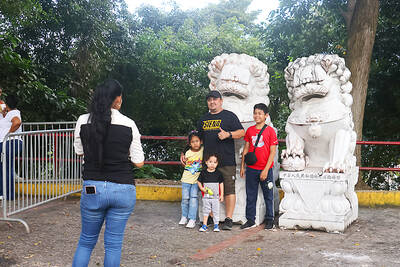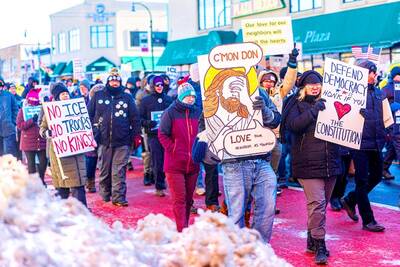After enduring wars, earthquakes, fires and poverty-driven neglect, the walled city of Intramuros that makes up the Philippine capital’s historic center may rise again as a tourist attraction.
Government planners see the UNESCO World Heritage listed — but famously dilapidated — site becoming one of Manila’s biggest draws, similar to Singapore’s Clarke Quay, but with the added color of centuries of history.
“We’re going to make this the ‘in’ place to be,” Intramuros administration chief Jose Capistrano said.
“It will be a living Intramuros with tabernas and tapas,” he said, referring to Spanish restaurants and their signature finger snacks.
Eventually, the administration hopes to have fireworks displays and light shows projected on the structure’s 6m high walls at night, Capistrano told reporters.
The ambitious project will involve rehabilitating and reconstructing buildings, as well as developing a riverside area called the Maestranza Park into a mall for upmarket restaurants and shops.
However, this endeavor will require tens of millions of dollars in investments that the government cannot afford, so it is hoping the private sector will sign up.
Administration officials have been meeting with some of the country’s real-estate giants to drum up their interest in investing in the project, and Capistrano said their reactions had been very favorable.
“They are interested in the projects. We feel confident that they will be coming in,” he said.
Capistrano said that although a definitive cost estimate for the renovation had not yet been finalized, potential investors were not intimidated by the large scope of the project.
“No one said it might cost too much. The reaction when we tell them what these projects are has been very good,” he said, adding he hoped to start a bidding process by the end of the year.
The 64 hectare Intramuros area — the name literally means “within the walls” — served as the heart of Manila’s political, religious and cultural life from its founding by Spanish colonial rulers in 1571.
Its 4.2km of walls surrounded most of the government’s offices, as well as major churches, schools and trading centers during the three centuries the country was under Spanish rule, which ended in 1898.
It was designed with walls, gates and gun emplacements to protect the Spanish residents from the Filipino masses, as well as guard the mouth of Manila’s main river, the Pasig.
Chinatown was also famously placed within cannonball distance of Intramuros so the Spanish could fire down on the Chinese traders when they became too troublesome.
However, Intramuros started falling into decline after the Spanish left, with most of the damage occurring during World War II, when US forces shelled Japanese troops hiding inside the walls.
Many historic buildings, including nine of the 10 churches within Intramuros, were destroyed in the war. Some of these derelict structures are still standing, a reminder of the area’s lost grandeur.
Over the centuries, earthquakes and fires have also taken their toll. And while Intramuros’s value is in its history, modern pressures have continued to erode its structures.
Parts of Intramuros today include a busy commercial and government district, containing several government offices, four major universities and a variety of businesses.
All of this results in congestion, noise, frequent traffic jams and a chronic lack of parking space.
The area also houses more than 3,000 families of squatters who often can be seen asking tourists for alms while their shanties and graffiti mar the image of the walled city, Capistrano said.
He said the administration had limited power to evict the squatters. Many of them are on private property and are protected by laws designed to help the urban poor.
Tourism professionals operating in the area look forward to the upgrade, but question whether the government can deliver amid the deterioration, overcrowding and squalor that have become common in parts of Intramuros.
“We need restructuring of the buildings, getting rid of the slumdwellers, beautifying the place. There is so much garbage, there are eyesores,” said Jose Mananzan, head of the Intramuros Tourism Council.
Nevertheless, even without private investors, the government has taken the first step, spending 150 million pesos (US$3.5 million) to turn the ruined shell of a church into a museum housing religious artifacts, Capistrano said.
Portions of the old historic wall in Maestranza that were torn down in the 1900s have also already been reconstructed through a Japanese grant, he said.
This time, instead of housing gunpowder and cannon balls, the wall’s vaulted inner chambers will hopefully house cafes and shops.
More restoration work is under way at the Intramuros’s garrison of Fort Santiago, where workers trained under a Spanish government grant are pulling down cement walls and replacing them with more authentic adobe and lime.
Under the Spanish program, two masons from Mexico taught the Filipinos how to mix lime and shape stone to recreate the original look of the building, which will become the new Intramuros visitors’ center.
“We replaced the old timber that had rotted, but we are bringing it back to its original look,” foreman Jose de Lara said.

Shamans in Peru on Monday gathered for an annual New Year’s ritual where they made predictions for the year to come, including illness for US President Donald Trump and the downfall of Venezuelan President Nicolas Maduro. “The United States should prepare itself because Donald Trump will fall seriously ill,” Juan de Dios Garcia proclaimed as he gathered with other shamans on a beach in southern Lima, dressed in traditional Andean ponchos and headdresses, and sprinkling flowers on the sand. The shamans carried large posters of world leaders, over which they crossed swords and burned incense, some of which they stomped on. In this

Near the entrance to the Panama Canal, a monument to China’s contributions to the interoceanic waterway was torn down on Saturday night by order of local authorities. The move comes as US President Donald Trump has made threats in the past few months to retake control of the canal, claiming Beijing has too much influence in its operations. In a surprising move that has been criticized by leaders in Panama and China, the mayor’s office of the locality of Arraijan ordered the demolition of the monument built in 2004 to symbolize friendship between the countries. The mayor’s office said in

‘TRUMP’S LONG GAME’: Minnesota Governor Tim Walz said that while fraud was a serious issue, the US president was politicizing it to defund programs for Minnesotans US President Donald Trump’s administration on Tuesday said it was auditing immigration cases involving US citizens of Somalian origin to detect fraud that could lead to denaturalization, or revocation of citizenship, while also announcing a freeze of childcare funds to Minnesota and demanding an audit of some daycare centers. “Under US law, if an individual procures citizenship on a fraudulent basis, that is grounds for denaturalization,” US Department of Homeland Security Assistant Secretary Tricia McLaughlin said in a statement. Denaturalization cases are rare and can take years. About 11 cases were pursued per year between 1990 and 2017, the Immigrant Legal Resource

‘RADICALLY DIFFERENT’: The Kremlin said no accord would be reached if the new deal with Kyiv’s input did not remain within the limits fixed by the US and Russia in August Ukrainian President Volodymyr Zelenskiy is to meet US President Donald Trump in Florida this weekend, but Russia on Friday accused him and his EU backers of seeking to “torpedo” a US-brokered plan to stop the fighting. Today’s meeting to discuss new peace proposals comes amidst Trump’s intensified efforts to broker an agreement on Europe’s worst conflict since World War II. The latest plan is a 20-point proposal that would freeze the war on its current front line, but open the door for Ukraine to pull back troops from the east, where demilitarized buffer zones could be created, according to details revealed by